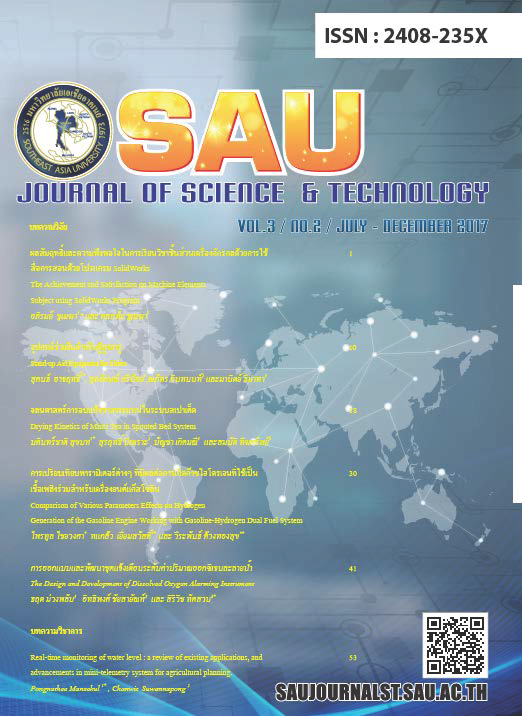การเปรียบเทียบพารามิเตอร์ต่างๆ ที่มีผลต่อการเกิดก๊าซไฮโดรเจนที่ใช้เป็นเชื้อเพลิงร่วมสำหรับเครื่องยนต์แก๊สโซลีน
Main Article Content
บทคัดย่อ
การวิจัยนี้เป็นการศึกษาเชิงการทดลองเกี่ยวกับพารามิเตอร์ต่างๆ ที่มีผลต่อการเกิดก๊าซไฮโดรเจนที่ใช้เป็นเชื้อเพลิงร่วมสำหรับเครื่องยนต์แก๊สโซลีน ซึ่งในการทดลองในครั้งนี้ได้ทำการออกแบบรีแอ็คเตอร์ที่ใช้น้ำปริมาตร 1000 ลูกบาศก์เซนติเมตร เป็นอีเล็กโตรไลท์, ใช้แผ่นสแตนเลส 304 ขนาด 4x8 มิลลิเมตร หนา 2 มิลลิเมตร เป็นอิเล็กโทรดและใช้แบตเตอรี่ขนาด 12 โวลท์ 65 แอมป์-ชั่วโมง เป็นแหล่งจ่ายไฟ, วิธีการทดลองทำโดยการปรับเปลี่ยนพารามิเตอร์ต่างๆ ซึ่งประกอบด้วย จำนวนแผ่นธาตุ (Plate cell), ระยะห่างระหว่างแผ่นธาตุ (Gap) และความเข้มข้นของสารละลาย (Concentration of solutions) หลังจากนั้นจึงทำการเปรียบเทียบผลการทดลองซึ่งประกอบด้วย อัตราการไหลของก๊าซ, กระแสไฟที่ไหลผ่านแผ่นธาตุ, อุณหภูมิของรีแอคเตอร์ และแรงเคลื่อนไฟฟ้าของแบตเตอรี่ ตลอดจนผลของการนำก๊าซไฮโดรเจนไปใช้เป็นเชื้อเพลิงร่วมสำหรับเครื่องยนต์แก๊สโซลีน ผลการทดลองพบว่า รีแอคเตอร์ที่เติมสารละลายในน้ำอิเล็กโตรไลท์ขนาด 11 เซลล์, มีระยะห่างระหว่างเซลล์ 2 มิลลิเมตร จะให้อัตราการไหลของก๊าซไฮโดรเจนสูงสุด และเมื่อนำก๊าซไฮโดรเจนไปใช้เป็นเชื้อเพลิงร่วมสำหรับเครื่องยนต์แก๊สโซลีน พบว่าเครื่องยนต์แก๊สโซลีนขนาดปริมาตรกระบอกสูบ 1600 ลูกบาศก์เซนติเมตร ที่ใช้ระบบเชื้อเพลิงแก๊สโซลีนร่วมกับไฮโดรเจน สามารถประหยัดเชื้อเพลิงได้สูงสุด 25 เปอร์เซ็นต์ ที่ความเร็วรอบ 1500 รอบต่อนาที เมื่อเทียบกับเครื่องยนต์แก๊สโซลีนที่ใช้ระบบเชื้อเพลิงปกติ
Article Details
เอกสารอ้างอิง
[2] W. McDonall, M. Eames, Forecast, scenarios, visions, backcasts and roadmaps to the hydrogen economy: a review of the hydrogen futures literature., Energy Policy, 34 (2006)1236 – 1250.
[3] K. Zhou, J. Ferreira, S.D. Haan, Optimal energy management strategy and system sizing method for standalone photovoltaic-hydrogen systems., Inter. J. Hydrogen Energy, 33 (2008) 477 – 489.
[4] S. SA, B. F, V. TN, Wind energy and the hydrogen economy-review of the technology., Solar Energy, 78 (2005)647 – 660.
[5] V. Pérez-Herranz, M. Pérez-Page, R. Beneito, Monitoring and control of a hydrogen production and storage system consisting of water electrolysis and metal hydrides, Inter. J. Hydrogen Energy, 35 (2010) 912–919.
[6] J.C. Ganley, High temperature and pressure alkaline electrolysis, Inter. J. Hydrogen Energy, 34 (2009) 3604–3611.
[7] K. Schoots, F. Ferioli, G.J. Kramer, B.C.C.v.d. Zwaan, Learning curves for hydrogen production technology: An assessment of observed cost reductions, Inter. J. Hydrogen Energy, 33 (2008) 2630–2645.
[8] G.E. Ahmad, E.T.E. Shenawy, Optimized photovoltaic system for hydrogenproduction, Renewable Energy, 31 (2006) 1043–1054.
[9] E.T.E. Shenawy, H. H., Annual Performance of a Photovoltaic Hydrogen Electrolyzer System in Egypt, in: The Pacific Rim Energy and Sustainability Congress, The Hiroshima Crowne Plaza, Japan, 2012.
[10]Z. Wang, R.R. Roberts, G.F. Naterer, K.S. Gabriel, Comparison of thermochemical, electrolytic,
photoelectrolytic and photochemical solar-to-hydrogen production technologies., Inter. J. Hydrogen Energy, 37(21)(2012)16287–16301.
[11] A. Ramadan, E. El-Shenawy, A.A. Dayem, S. Eid, A. Optimization of PV-Hydrogen Electrolyzes System, in: Third International Conference on Engineering Science & Technology, Cairo, Egypt, 2008.
[12] N. Chennouf, N. Settou, B. Negrou, K. Bouziane, B.Dokkar, Experimental Study of Solar Hydrogen Production Performance by Water Electrolysis in the South of Algeria, Energy Procedia, 18 (2012) 1280 – 1288.
13] D.M. See, R.E. White, Temperature and concentration dependence of the specific conductivity of concentrated solutions of potassium hydroxide, J. Chem. Eng. Data, 42 (1997) 1266-1268.
[14] H. Wendt, H. Plzak, Hydrogen production by water electrolysis, Kerntechnik, 56 (1991) 22–28.
[15] Æ. Ulleberg, Modeling of advanced alkaline electrolyzers: a system simulation approach, Inter. J. of Hydrogen Energy, 28 (2003) 21-33.
[16] X. Qin, F. Gao, G. Chen, Effects of the geometry and operating temperature on the stability of Ti/IrO2–SnO2-Sb2O5 electrodes for O2 evolution., J Appl Electrochem, (2010)1797–1805.
[17] Allenby, S., Chang, W.C., Megaritis, A. and Wyszynski, M.L., 2001, "A Way to maintain Combustion Stability in Natural Gas Fuelled Engine with EGR, the Potential of Fuel Reforming", Journal of Automobile Engineering, Vol, 215, Part D., pp.405-418
[18] Sierens,R. and Rosseel, E., 2000, "Variable Composition Hydrogen/Natrual Gas Mixtures for Incerased Engine Efficiency and Decreased Emissions", ASME Journal of Engineering for Gas Turbines and Power, Vol. 122, pp. 135-140
[19] Larsen,J.F. and Wallace, J.S., 1997,"Comparison of Emissions and Efficiency of a Turbocharged Lean-Burn Natrual Gas and Hythane-Fuelled Engine", ASME Journal of Engineering for Gas Turbines and Power, Vol. 119, pp. 218-226
[20] Raman, V., Hansel, J., Fulton, J., Lynch, F. and Bruderly, D., 1994, "Hythane-An Ultra Clean Transportation Fuel", Proceeding 10th World Hydrogen Energy Conference, Cocoa Beach, Vol. 3, pp. 1797-1806
[21] P. Chaiwongsa, N. Pornsuwancharoen, P.P. Yupapin, Effective hydrogen generator testing for on-site small engine, Frontier Research in Nanoscale Science and Technology, Physics Procedia 2 (2009) 93–100


